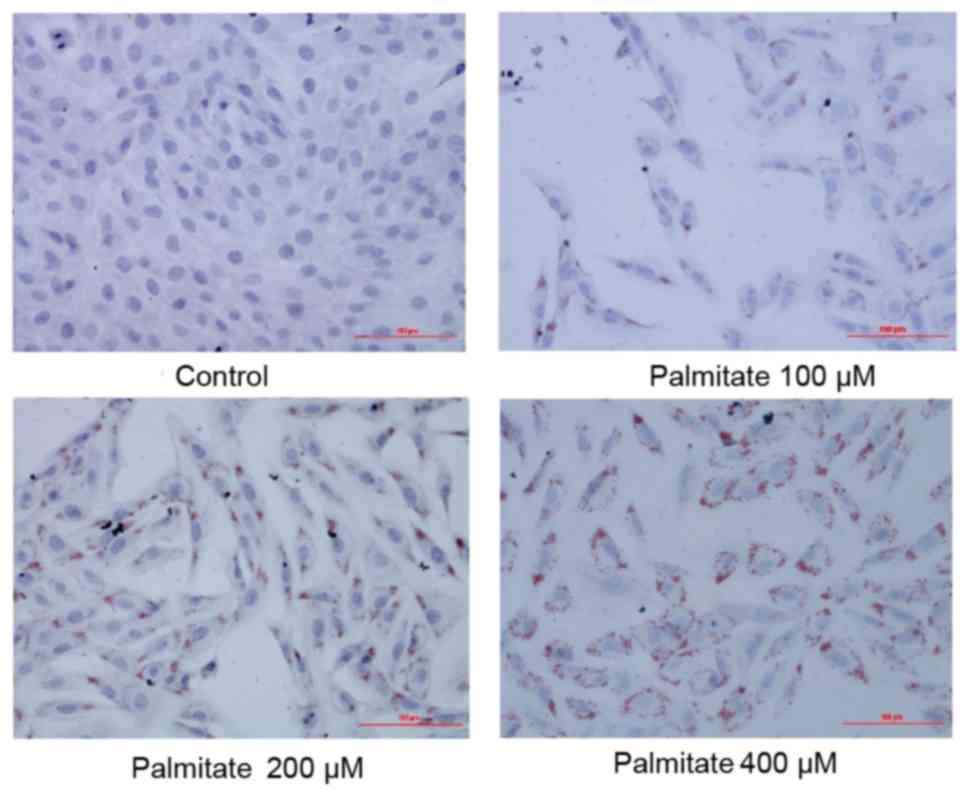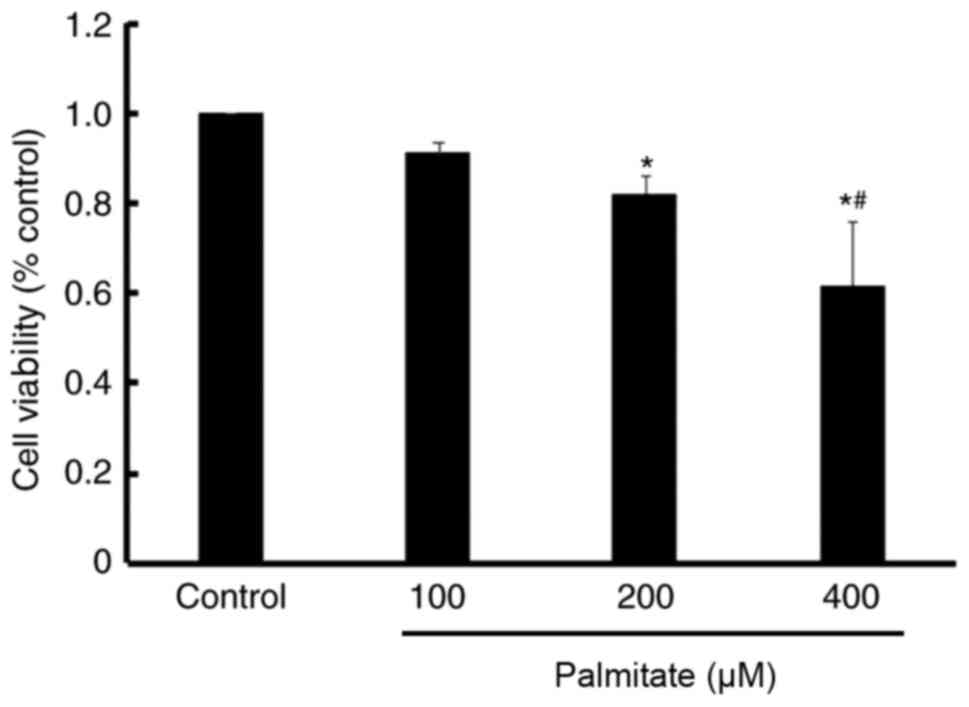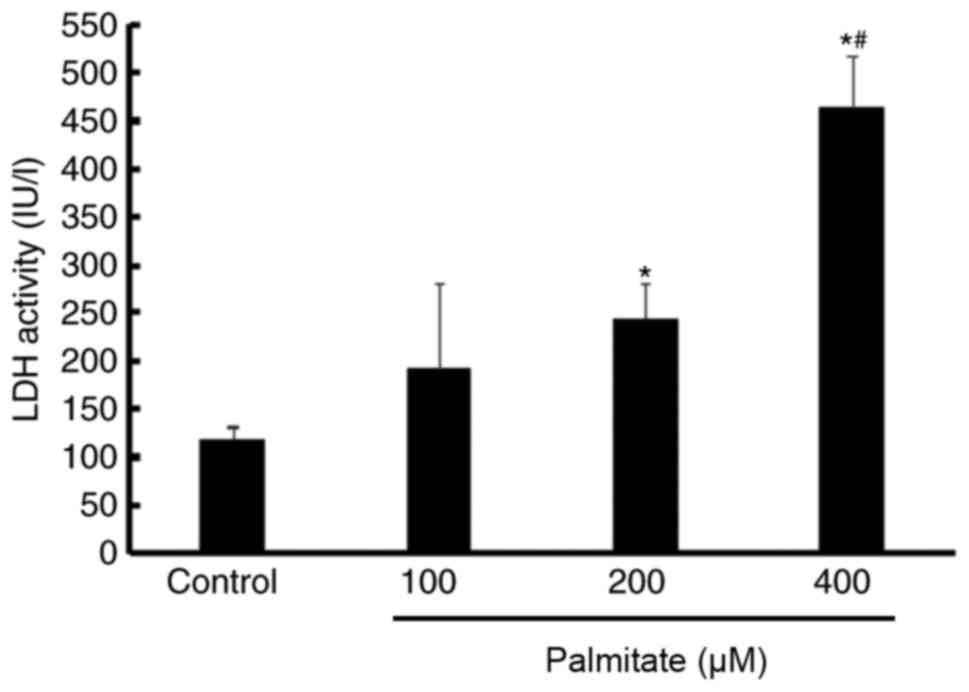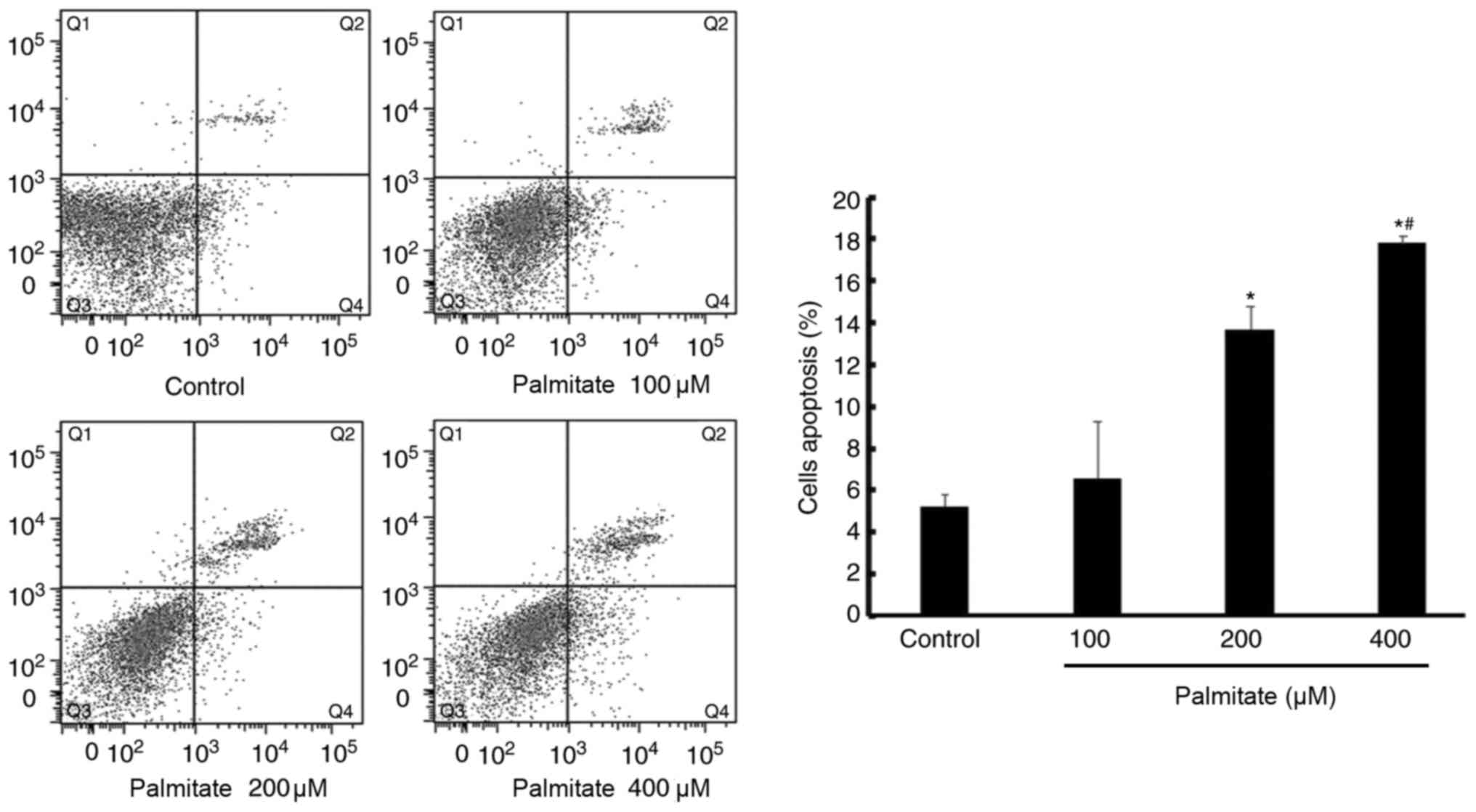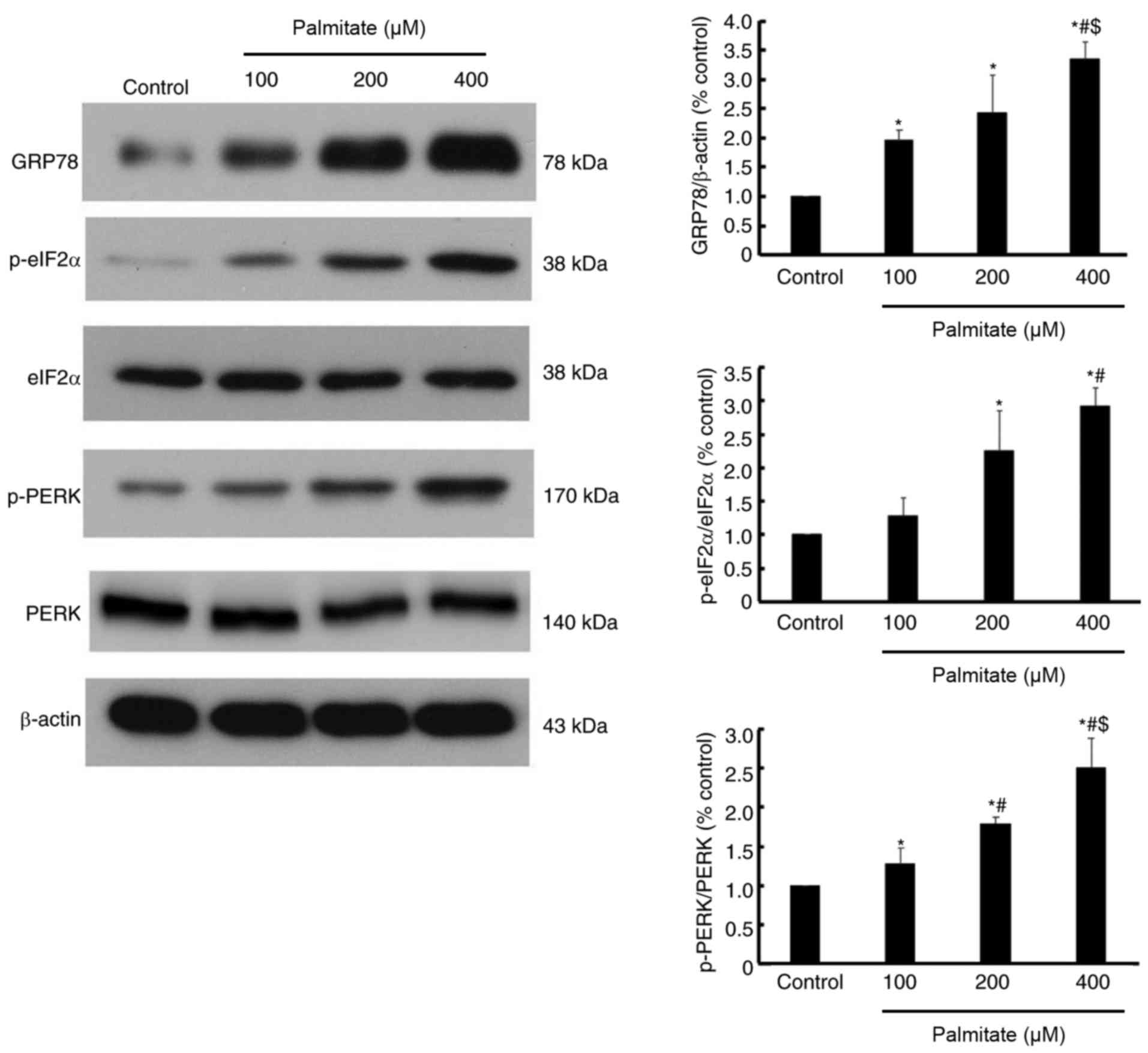Palmitate induces myocardial lipotoxic injury via the endoplasmic reticulum stress‑mediated apoptosis pathway
- Authors:
- Published online on: August 31, 2017 https://doi.org/10.3892/mmr.2017.7404
- Pages: 6934-6939
Abstract
Introduction
Lipotoxic cardiomyopathy often occurs in patients with diabetes and obesity, and is attributed to excessive accumulation of lipids and their intermediate products in cardiomyocytes (1). Diabetes and obesity usually result in the disordered lipid metabolism and elevation of free fatty acids (FFAs) (2). Previous studies have demonstrated that increased FFAs, particularly saturated FFAs, induce myocardial injury, and ultimately result in heart dysfunction to some extent (3,4). However, the underlying mechanisms responsible for lipotoxic cardiomyopathy remain unknown.
The endoplasmic reticulum (ER) is a fundamental organelle that has a key role in the modification, folding and oligomerization of the majority synthesized structural and secreted proteins (5). It has been established that multiple physiological and pathological conditions, including hypoxia, hyperglycemia and acidosis, can result in ER homeostasis breakdown and an elevated accumulation of unfolded/misfolded proteins within the ER lumen, which is commonly termed ‘ER stress’ (6). In order to cope with ER stress, cells initially induce the unfolded protein response (UPR) signaling to adapt to stress conditions and maintain the balance of ER homeostasis again. However, prolonged or excessive ER stress will trigger ER stress-mediated apoptosis pathway, which is an apoptosis signal pathway independent of the death-receptor and mitochondria mediated-apoptosis pathways (7).
Palmitate (PA), a type of saturated FFA, induces cardiomyocyte apoptosis (8), and thus, is used to mimic cardiomyocytes lipotoxicity in vitro (9). Several previous studies have reported that PA induces ER stress-mediated apoptosis in hepatocytes (10), pancreatic β cells (11) and mature adipocytes (12), but whether PA induces ER stress-mediated apoptosis in cardiomyocytes remains unknown. Therefore, the aim of the present study was to explore the role of ER stress-mediated apoptosis pathway in PA-induced cardiomyocyte lipotoxicity.
Materials and methods
Cell culture and PA treatment
The H9c2 rat cardiomyocyte cell line, obtained from the Shanghai Institutes for Biological Sciences (Shanghai, China), was routinely cultured in Dulbecco's modified Eagle's medium (Hyclone; GE Healthcare Life Sciences, Logan, UT, USA) supplemented with 10% fetal bovine serum (Hangzhou Sijiqing Biological Engineering Materials Co., Ltd., Hangzhou, China), 100 U/ml penicillin and 100 µg/ml streptomycin in a humidified atmosphere at 37°C with 5% CO2. When the confluence of H9c2 cells was ~80%, PA (Sigma-Aldrich; Merck KGaA, Darmstadt, Germany) at doses of 100, 200 and 400 µM was added to the medium and incubated for 12 h. An ER stress inhibitor, 4-phenyl butyric acid (4-PBA; 5 mM), was administrated 90 min before 400 µM PA treatment.
Oil Red O staining
Oil Red O staining was used to measure the accumulation of intracellular lipids. Briefly, 150 mg Oil Red O powder (Sigma-Aldrich; Merck KGaA) was dissolved in 50 ml 60% isopropanol to prepare the Oil Red O reserve solution (3 mg/ml) and further diluted by distilled water (3:2) to prepare a working solution. H9c2 cells were fixed in 4% paraformaldehyde for 30 min at room temperature, washed with PBS three times, then followed by incubation with the Oil Red O working solution for 30 min at room temperature. After washing with PBS three times, nuclei were counterstained with 50% hematoxylin for 2 min at room temperature. Finally, the result of Oil Red O staining was observed under an optical microscope (Olympus Corporation, Tokyo, Japan).
Measurement of cell viability
MTT assay was used to determine the cell viability following PA treatment. Briefly, H9c2 cells were seeded in a 96-well plate and treated with various concentrations of PA as described above. After 12 h, the medium was removed and replaced with 0.5 mg/ml MTT solution (Sigma-Aldrich; Merck KGaA), 200 µl per well. After incubation at 37°C for 4 h, the MTT solution was removed and each well was washed with PBS three times. The precipitated formazan in each well was solubilized by dimethyl sulfoxide (Sigma-Aldrich; Merck KGaA) and the optical density value was detected by an automated microplate reader (Thermo Fisher Scientific, Inc., Waltham, MA, USA) at 490 nm.
Measurement of cell injury
Lactate dehydrogenase (LDH) activity in the culture medium was detected to determine the injury of H9c2 cells using a commercial LDH assay kit (Nanjing Jiancheng Bioengineering Institute, Nanjing, China) according to the manufacturer's protocols.
Measurement of apoptosis
Apoptosis was detected by flow cytometry analysis using the PE-labeled Annexin V/7-aminoactinomycin D apoptosis detection kit (BD Biosciences, Franklin Lakes, NJ, USA) according to the manufacturer's protocols.
Western blotting analysis
Cells were harvested after PA treatment for 12 h and mixed with radioimmunoprecipitation assay lysis buffer (Beyotime Institute of Biotechnology, Nanjing, China) and protease inhibitor phenylmethanesulfonyl fluoride on ice for 20 min. Proteins were extracted from cells following 5 min of centrifugation of 13,000 × g at 4°C. The concentration of protein was measured using Enhanced BCA Protein Assay kit (Beyotime Institute of Biotechnology). For western blot analysis, 50 µg protein denatured by heating was subjected to 10% SDS-polyacrylamide gel electrophoresis for separation and then transferred to polyvinylidene difluoride membranes. The membrane was blocked using 2% bovine serum albumin (BSA) for 1 h at room temperature and then incubated overnight at 4°C with the specific primary antibodies including monoclonal anti-78 kDa glucose-regulated protein (GRP78; cat no. 3183; 1:1,000), anti-protein kinase R-like endoplasmic reticulum kinase (PERK; cat no. 3192; 1:1,000), anti-phospho (p)-PERK (cat no. 3179; 1:1,000), anti-eukaryotic initiation factor 2 α (eIF2α; cat no. 5324; 1:1,000), anti-p-eIF2α (cat no. 3398; 1:1,000) (all from Cell Signaling Technology, Inc., Danvers, MA, USA), anti-cleaved caspase-12 (cat no. ab18766; 1:1,000), anti-C/EBP homologous protein (CHOP; 1:1,000, cat no. ab11419) (both from Abcam, Cambridge, UK), and anti-β-actin (TA-09; 1:2,000; Beijing Zhongshan Jinqiao Biotechnology Co., Ltd., Beijing, China). Subsequently, the membranes were incubated with horseradish peroxidase-conjugated goat anti-rabbit (cat no. sc-2004; 1:2,000) or rabbit anti-mouse immunoglobulin G (cat no. sc-358914; 1:2,000) (both from Santa Cruz Biotechnology, Inc., Dallas, TX, USA) at 37°C for 2 h. Detection of protein band was performed using an enhanced chemiluminescence kit (Santa Cruz Biotechnology, Inc.) according to the manufacturer's protocols. The levels of phosphorylated proteins were normalized to their corresponding total protein levels. Relative densitometry was calculated using ImageJ software version 2× (National Institutes of Health, Bethesda, MD, USA).
Statistical analysis
The data were expressed as the mean ± standard deviation. Statistical analysis was performed by software SPSS 17.0 version (SPSS, Inc., Chicago, IL, USA). Differences between groups were initially evaluated using one-way analysis of variance, and if the differences were significant, multiple comparison analysis was further performed using Fisher's least significant difference test. P<0.05 was considered to indicate a statistically significant difference.
Results
Effect of PA on cell lipid accumulation
The result of Oil Red O staining demonstrated a gradual increase in the extent of lipid accumulation in H9c2 cells following treatment with increasing concentrations of PA (0, 100, 200 and 400 µM; Fig. 1), suggesting PA induced excessive lipid accumulation in H9c2 cells.
Effect of PA on cell viability
An MTT assay demonstrated a significant decrease in cell viability following treatment with 200 and 400 µM PA compared with the control. Furthermore, PA reduced cell viability in a dose-dependent manner (Fig. 2).
Effect of PA on cell injury
An LDH assay indicated that LDH activity was significantly increased by 200 and 400 µM PA compared with the control. Furthermore, LDH activity in the 400 µM PA treatment group was higher than in the 200 µM PA group, which suggested that PA induced H9c2 cell injury in a dose-dependent manner (Fig. 3).
Effect of PA on cell apoptosis
PA (200 and 400 µM) significantly increased H9c2 cell apoptosis compared with the control, demonstrated by increased apoptosis rate. In addition, apoptosis induced by PA was also displayed in a dose-dependent manner (Fig. 4).
Effect of PA on the expression of ER stress markers
As presented in Fig. 5, the expression of GRP78, a well-established ER stress marker, was increased by various dose of PA in a dose-dependent manner. Furthermore, the phosphorylation of eIF2α and PERK were also increased in a dose-dependent manner (Fig. 5), which indicated that PERK/eIF2α signaling may be activated by PA.
Effect of PA on the ER stress-mediated apoptosis pathway
Various doses of PA significantly increased the expression of CHOP compared with the control; however, no significant differences in the expression of CHOP were detected among the different PA-treated groups. Furthermore, various dose of PA significantly increased the expression of cleaved caspase-12 in a dose-dependent manner (Fig. 6).
Effect of 4-PBA on PA-induced apoptosis
In order to reconfirm the role of ER stress in PA induced apoptosis, 4-PBA, a specific ER stress inhibitor, was administered to examine the changes in cell apoptosis rate and the expression of CHOP and cleaved caspase-12 following ER stress inhibition. The results revealed that 400 µM PA significantly increased H9c2 cells apoptosis rate, but this effect was reversed by treatment with 4-PBA (Fig. 7). Similarly, the expression of CHOP and cleaved caspase-12 were increased by 400 µM treatment, but were also reversed by 4-PBA treatment (Fig. 8).
Discussion
Myocardial damage caused by hyperlipemia predominantly occurs by two mechanisms: In most cases, hyperlipemia, a well-known independent risk factor of coronary heart disease, accelerates the development of coronary atherosclerosis and results in myocardial ischemia, and even myocardial necrosis, eventually (13); additionally, sustained and excessive hyperlipemia can also directly result in myocardial damage, termed ‘myocardial lipotoxic injury’ during severe metabolic disorders, including diabetes and severe obesity (14,15). The present study demonstrated that PA promoted excessive lipid deposition in cardiomyocytes and resulted in decreased cell viability, increased LDH activity and apoptosis rate in a dose-dependent manner, which is consistent with the findings of Wei et al (4,16). Therefore, the present study reconfirmed that PA could induce myocardial lipotoxic injury in vitro.
ER stress, an important adaptive response in eukaryotic cells, is often activated under the conditions of various pathophysiological procedures, including anoxia (17), poisoning (18) and infection (19). In particular, previous studies have demonstrated that ER stress is involved in different cardiovascular diseases including atherosclerosis (20), hypertension (21) and heart failure (22). The current study demonstrated that GRP78, a marker of ER stress, was elevated in cardiomyocytes following PA treatment. Furthermore, PERK/eIF2α, part of a well-established ER stress-associated pathway, were activated by PA treatment, as demonstrated by increased phosphorylation of PERK and eIF2α. The current results were similar to previous reports indicating that ER stress is activated in response to chronically elevated free fatty acids in hepatocytes (10) and pancreatic β cells (11).
However, ER stress is a double-edged sword, in that prolonged or excessive ER stress will trigger an ER stress-mediated apoptosis pathway (7). Unlike the death receptor- and mitochondria-mediated apoptosis pathways, specific ER stress-induced apoptosis proteins, including CHOP and caspase-12, were activated (23). One of the notable novel findings of the current study is that myocardial lipotoxic injury induced by various doses of PA were involved in the activation of ER stress-mediated apoptosis pathway. Although, Park et al (24) demonstrated that ER stress-mediated autophagy had an important role in regulating myocardial lipotoxic injury induced by PA, whether ER stress-mediated apoptosis is implicated in the onset of myocardial lipotoxic injury remains unknown. The present study demonstrated that CHOP and cleaved caspase-12 were significantly up-regulated in cardiomyocytes when treated with different dose of PA, but the effect reversed following ER inhibition using 4-PBA. This indicated that myocardial lipotoxic injury induced by PA may be involved in the activation of the ER stress-mediated apoptosis pathway.
In conclusion, the current study demonstrated that PA induces myocardial lipotoxic injury, potentially by triggering ER stress and the ER stress-mediated apoptosis pathway.
Acknowledgements
This study was supported by Fund for National Natural Science Foundation of China (grant no. 81670320), the Scientific Research of The First Hospital of China Medical University (grant no. fsfh1501) and the Natural Science Foundation of Liaoning Province (grant no. 201602826).
References
|
Ussher JR: The role of cardiac lipotoxicity in the pathogenesis of diabetic cardiomyopathy. Expert Rev Cardiovasc Ther. 12:345–358. 2014. View Article : Google Scholar : PubMed/NCBI | |
|
Carley AN and Severson DL: Fatty acid metabolism is enhanced in type 2 diabetic hearts. Biochim Biophys Acta. 1734:112–126. 2005. View Article : Google Scholar : PubMed/NCBI | |
|
Gambert S, Vergely C, Filomenko R, Moreau D, Bettaieb A, Opie LH and Rochette L: Adverse effects of free fatty acid associated with increased oxidative stress in postischemic isolated rat hearts. Mol Cell Biochem. 283:147–152. 2006. View Article : Google Scholar : PubMed/NCBI | |
|
Wei CD, Li Y, Zheng HY, Tong YQ and Dai W: Palmitate induces H9c2 cell apoptosis by increasing reactive oxygen species generation and activation of the ERK1/2 signaling pathway. Mol Med Rep. 7:855–861. 2013. View Article : Google Scholar : PubMed/NCBI | |
|
Phillips MJ and Voeltz GK: Structure and function of ER membrane contact sites with other organelles. Nat Rev Mol Cell Biol. 17:69–82. 2016. View Article : Google Scholar : PubMed/NCBI | |
|
Groenendyk J, Sreenivasaiah PK, Kim DH, Agellon LB and Michalak M: Biology of endoplasmic reticulum stress in the heart. Circ Res. 107:1185–1197. 2010. View Article : Google Scholar : PubMed/NCBI | |
|
Sano R and Reed JC: ER stress-induced cell death mechanisms. Biochim Biophys Acta. 1833:3460–3470. 2013. View Article : Google Scholar : PubMed/NCBI | |
|
Listenberger LL, Ory DS and Schaffer JE: Palmitate-induced apoptosis can occur through a ceramide-independent pathway. J Biol Chem. 276:14890–14895. 2001. View Article : Google Scholar : PubMed/NCBI | |
|
Haffar T, Bérubé-Simard FA and Bousette N: Cardiomyocyte lipotoxicity is mediated by Il-6 and causes down-regulation of PPARs. Biochem Biophys Res Commun. 459:54–59. 2015. View Article : Google Scholar : PubMed/NCBI | |
|
Cao J, Dai DL, Yao L, Yu HH, Ning B, Zhang Q, Chen J, Cheng WH, Shen W and Yang ZX: Saturated fatty acid induction of endoplasmic reticulum stress and apoptosis in human liver cells via the PERK/ATF4/CHOP signaling pathway. Mol Cell Biochem. 364:115–129. 2012. View Article : Google Scholar : PubMed/NCBI | |
|
Lai E, Bikopoulos G, Wheeler MB, Rozakis-Adcock M and Volchuk A: Differential activation of ER stress and apoptosis in response to chronically elevated free fatty acids in pancreatic beta-cells. Am J Physiol Endocrinol Metab. 294:E540–E550. 2008. View Article : Google Scholar : PubMed/NCBI | |
|
Yin J, Wang Y, Gu L, Fan N, Ma Y and Peng Y: Palmitate induces endoplasmic reticulum stress and autophagy in mature adipocytes: Implications for apoptosis and inflammation. Int J Mol Med. 35:932–940. 2015. View Article : Google Scholar : PubMed/NCBI | |
|
van Rooy MJ and Pretorius E: Obesity, hypertension and hypercholesterolemia as risk factors for atherosclerosis leading to ischemic events. Curr Med Chem. 21:2121–2129. 2014. View Article : Google Scholar : PubMed/NCBI | |
|
Wende AR and Abel ED: Lipotoxicity in the heart. Biochim Biophys Acta. 1801:311–319. 2010. View Article : Google Scholar : PubMed/NCBI | |
|
Goldberg IJ, Trent CM and Schulze PC: Lipid metabolism and toxicity in the heart. Cell Metab. 15:805–812. 2012. View Article : Google Scholar : PubMed/NCBI | |
|
Wei CD, Li Y, Zheng HY, Sun KS, Tong YQ, Dai W, Wu W and Bao AY: Globular adiponectin protects H9c2 cells from palmitate-induced apoptosis via Akt and ERK1/2 signaling pathways. Lipids Health Dis. 11:1352012. View Article : Google Scholar : PubMed/NCBI | |
|
López-Hernández B, Ceña V and Posadas I: The endoplasmic reticulum stress and the HIF-1 signalling pathways are involved in the neuronal damage caused by chemical hypoxia. Br J Pharmacol. 172:2838–2851. 2015. View Article : Google Scholar : PubMed/NCBI | |
|
Chen S, Melchior WB Jr and Guo L: Endoplasmic reticulum stress in drug- and environmental toxicant-induced liver toxicity. J Environ Sci Health C Environ Carcinog Ecotoxicol Rev. 32:83–104. 2014. View Article : Google Scholar : PubMed/NCBI | |
|
Cui Y, Zhao D, Barrow PA and Zhou X: The endoplasmic reticulum stress response: A link with tuberculosis? Tuberculosis (Edinb). 97:52–56. 2016. View Article : Google Scholar : PubMed/NCBI | |
|
Chistiakov DA, Sobenin IA, Orekhov AN and Bobryshev YV: Role of endoplasmic reticulum stress in atherosclerosis and diabetic macrovascular complications. Biomed Res Int. 2014:6101402014. View Article : Google Scholar : PubMed/NCBI | |
|
Guo XF and Yang XJ: Endoplasmic reticulum stress response in spontaneously hypertensive rats is affected by myocardial ischemia reperfusion injury. Exp Ther Med. 9:319–326. 2015. View Article : Google Scholar : PubMed/NCBI | |
|
Wang J, Hu X and Jiang H: ER stress-induced apoptosis: A novel therapeutic target in heart failure. Int J Cardiol. 177:564–565. 2014. View Article : Google Scholar : PubMed/NCBI | |
|
Jing G, Wang JJ and Zhang SX: ER stress and apoptosis: A new mechanism for retinal cell death. Exp Diabetes Res. 2012:5895892012. View Article : Google Scholar : PubMed/NCBI | |
|
Park M, Sabetski A, Chan Y Kwan, Turdi S and Sweeney G: Palmitate induces ER stress and autophagy in H9c2 cells: Implications for apoptosis and adiponectin resistance. J Cell Physiol. 230:630–639. 2015. View Article : Google Scholar : PubMed/NCBI |



